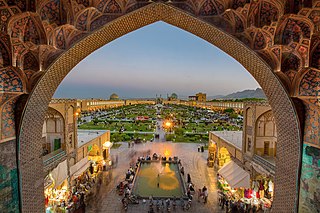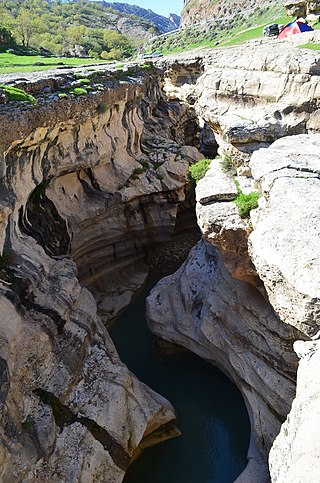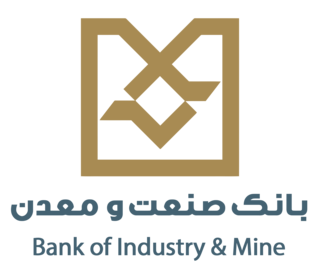
Isfahan, from its ancient designation Aspadana and, later, Spahan in middle Persian, rendered in English as Ispahan, is a major city in the Greater Isfahan Region, Isfahan Province, Iran. It is located 439.78 kilometres south of Tehran and is the capital of Isfahan Province. The city has a population of approximately 2,220,000, making it the third-largest city in Iran, after Tehran and Mashhad, and the second-largest metropolitan area.

Ilam Province is one of the 31 provinces of Iran. It is located in the western part of the country in Region 4 and covers 20,164.11 km2 (7,785.41 sq mi), while sharing 425 km (264 mi) of the border with Iraq, and also bordering on the provinces of Kermanshah, Lorestan, and Khuzestan. The largest city and also the provincial capital is Ilam.

Bank of Industry and Mine is an Iranian government owned specialized bank located in Tehran, Iran. It endeavours to increase economic growth through the development of industry and mining. Its purpose is to be an economic enterprise, providing banking facilities, development and investment in order to advance Iran's economy. It aims to promote the participation of the private sector in the fields of industry, mining, modern technologies and their associated services.

Nasrollah Entezam was a diplomat, politician, and minister, as well as Iranian Ambassador to the United States and France. He was the first Iranian Ambassador to the United Nations from 1947 to 1950 and President of the UN General Assembly during its fifth session in 1950.

Sarasadat Khadem al-sharieh, also known as Sara Khadem, is an Iranian chess player who holds the titles of International Master (IM) and Woman Grandmaster (WGM).

Order of Culture and Art is an Iranian state general order established by "Council of Iran Ministers" on November 21, 1990 and modified on June 27, 2007. The order has three classes and awarded by President of Iran. According to Article 17 of the Regulations on the Awarding of Government Orders of Iran, the Order of Culture and Art is awarded to those who "facilitate theirs thinking, passions and emotions to express deep Islamic and humanitarian concepts and to spread culture" in one of the following ways:
- Disseminating rich Islamic culture and eliminating society from foreign decadent culture
- Expanding the theoretical and disciplinary foundations of religious education
- Expanding national culture and revitalizing valuable social traditions
- Expressing creativity and presenting exquisite works of art or literature
- Pay particular attention to the country's cultural, artistic or literary heritage, so as to be effective in its restoration, preservation and utilization
- Introducing, describing, explaining, critiquing and presenting one of the artistic or literary disciplines internationally
- Inventing a new style in one of the artistic or literary disciplines
- Promote a culture of sacrifice and martyrdom in the community
- Creating remarkable and valuable artworks to convey the ideals and values of the Islamic Revolution and the Sacred Defense to future generations

Nasrollah Sajjadi is an Iranian politician and sports administrator who served as Vice and Acting Minister of Sports. He was acting Minister of Youth Affairs and Sports from 19 October until 1 November 2016. He assumed office after the resignation of Mahmoud Goudarzi and holds it until approval of the new minister. He was secretary-general of National Olympic Committee of the Islamic Republic of Iran and President of the Football Federation Islamic Republic of Iran in the 1980s and 1990s. He was also a member of the financial committee of Olympic Council of Asia and deputy Head of Physical Education Organization.
Fereydun Sahabi is an Iranian academic, writer, translator, and social activist. He was the first president of the Atomic Energy Organization of Iran and the second in the administration of President of Iran after the Iranian revolution.

Seifollah Kambakhshfard was an Iranian archaeologist, who specialized in archaeology and Ancient History of Iran.
Sepideh Mohammadian is an Iranian writer and lawyer. Her writings are mostly fiction about women living in contemporary Iran and the various problems they face. A lecture at Iranian Studies of Stanford University in 2015 concerning “Women In Contemporary Literature of Iran, Seeking Meaning and Awareness".

Mohammad Darvish is an Iranian environmentalist and desert researcher. He is currently the head on Environment committee in Iran branch of UNESCO. He has worked for three decades as a Desert Researcher and explorer of desertification components at the Research Institute of Iran’s Forest and Range lands.

National Organization for Civil Registration of Iran is one of the governmental organizations in Iran that is responsible for collecting information and population statistics of Iran. This organization with independent duties and functions is one of the subordinate institutions of the Ministry of Interior of Iran. The organization is responsible for providing basic registration information such as births, deaths and marriages, as well as issuing identity documents such as birth certificates and Identity certificate. The current head of the organization is Hashem Kargar. In Iran, the third day of Dey (month) has been named as National Organization for Civil Registration Day.
The Iran Technical and Vocational Training Organization or in brief I.R.T.V.T.O is one of the organizations affiliated to the Ministry of Cooperatives, Labour, and Social Welfare, which was formed from the merger of three educational institutions in 1980 in order to provide technical and vocational education. In addition to the central headquarters, this organization has 31 general administrations in provinces of Iran, an instructor training center, 552 Learning Center and over 11700 free technical and vocational schools. In order to achieve the latest science and technology news and to comply with international standards, the organization always tried to expand international relations, including with the International Labour Organization (ILO) and the International Organization for Vocational Training in other countries. In this regard, the organization, regardless of the interpretation of the overall organizational structure, carries out its activities only in the field of education, with the support of the research field.
The Iranian National Tax Administration or in brief INTA is one of the organizations affiliated to the Ministry of Economic Affairs and Finance in Iran which is responsible for handling the country's tax affairs. Among the tasks of this organization are reforming and mechanizing the country's tax system and implementing Value-added tax.

The Iranology Foundation is a scientific and research institute in Iran and Iranian studies is the main field of its activities. The Foundation's studies and researches are all topics and issues related to various manifestations of Iranian culture and civilization. The institute was established in 1997 under the supervision of the Presidential Administration of Iran.
The National Geoscience Database of Iran or in brief NGDIR is a scientific and research government agency in Iran which works in the field of Geology of Iran and centrally manages Geoscience data. This center was established in 1999 in the field of data collection authority with the aim of managing, preserving and sharing Geoscience data.
The Geological Survey and Mineral Exploration of Iran or in brief GSI is a government agency responsible for conducting geological and mineral surveys throughout the country, collecting the results of activities carried out in this field, establishing coordination, preparing and publishing geological maps of Iran. It is a subdivision of the Ministry of Industry, Mine and Trade, which was established in 1962 in cooperation with United Nations.

Ali Osat Hashemi is an Iranian reformist politician. He was born 1958 in Sonqor County, Kermanshah Province, Iran. He was the Deputy Minister of Iran's Ministry of Cooperatives, Labour, and Social Welfare and the head of the Iran Technical and Vocational Training Organization, from 2019 to 2021.
The Iranian Blood Transfusion Organization or acronymly IBTO is the highest and only decision-making authority in the field of supply and distribution of healthy blood and blood products in Iran. This organization was established in July 31, 1974.

Sheikh Nasrallah Shah-Abadi Persian: شیخ نصرالله شاه آبادی, was an Iranian Ayatollah. He represented the people of Tehran Province in the Fifth term of the Assembly of Experts.













